When I started tracking my walking metrics with Fitbit, I began walking faster and more frequently. I started running up and down flights of stairs and parking farther away from the office.
When I started tracking personal writing metrics, the same things happened. Because the numbers were in front of me, I worked to write faster than my last writing session, and I had a greater desire to write the next day to meet my monthly goal.
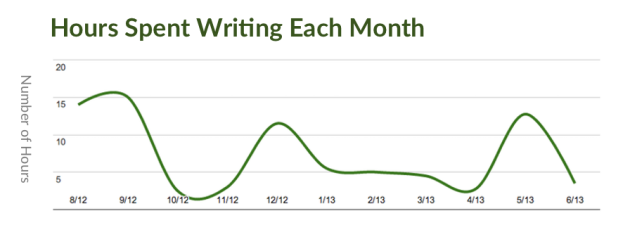
Two years ago I started tracking how many hours I spent writing fiction each month.
Now the fiction story I started has more than 100 pages and I’m writing more than 300 words per hour, in large part because I’m motivated by watching my personal metrics improve.
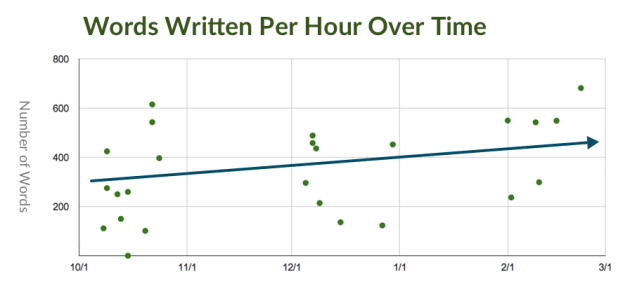
Check out how my writing speed has inched up over the last number of months.
Tracking personal writing metrics can make you a more prolific writer. More importantly, it can also make you more money, especially if you combine your personal metrics with other marketing metrics to get insights that other content marketers don’t have.
Why Should Content Marketers Track Personal Metrics?
After I learned there was power in tracking personal metrics, I wondered how this applied to my work. After alI, I spend more time writing at work than outside of work as Raven’s social media marketer. Using social media management tools helps with productivity, for sure, but keeping track helps me know what’s working.
Part of my job is creating content, so I started tracking personal writing metrics at Raven (starting with this blog post). By keeping track of a few things as I create content, I know a lot. For example, here’s what I know about the post you’re reading right now.
Great, that’s pretty, but so what?
Insights from Raw Data
Here are the questions you can answer after tracking personal writing metrics:
- Are you getting faster or slower at creating content?
- Are creating content more or less frequently?
- What part of the content creation process is the biggest bottleneck?
- What part of the process could you outsource?
- What part of the process could you spend more time on?
- Does your content require less editing and reworking over time?
Insights from Derived Data
What’s even more powerful are the insights you get after combining your personal writing metrics with more conventional metrics like conversions and unique visits. Do you have insight on the following?
- What type of content makes you the most money per hour spent creating it?
- Do you get a bigger pay off by creating three small pieces of content or one larger one?
- Is there a correlation between the time put into content and its conversion rate?
- Is there a correlation between conversions and percent of production time spend on any part of the production process?
5 Personal Writing Metrics To Track
If the answers to these questions are valuable to you, then here are the 5 personal writing metrics you can track to get the answers to these questions.
Use a Google Drive spreadsheet to keep track of:
- Parts of the Production Process
- Total Production Time
- Final Word Count
- Words Per Production Hour
- Value Per Production Hour
Here’s how I define each metric:
1. Parts of the Production Process
Don’t just track your time, but all time that goes into a piece of content. The goal is to track a piece of content’s performance, not individual performance. Did a designer or an editor pitch in? Ask how much time it took and add it as production time.
I recommend tracking the following stages of the process:
- Time Spent on Research
- Time Spent on Drafting
- Time Spent on Rewriting
- Time Spent on Editing
- Time Spent on Artwork
- Time Spent on SEO
2. Total Production Time
Once you know how long it takes to create different types of content, you’ll know if you have time to write that 800-word guest post. You’ll be able to meet deadlines with a boss or to show them with real data that their expectations are off.
There’s tons of flexibility here, though. Add another category if you want to track how much time you spend repurposing content, how much time you spend jotting down notes in the shower or brainstorming time. Tailor things based on major parts of your unique process.
If your data is in a spreadsheet format, you can start massaging it to find insights. For example, in Google Sheets, if you want to see the average percent of time spent on any part of the process, just highlight the relevant cells and click Insert > Chart to start building a chart of the data.
3. Final Word Count
Not only is this self-explanatory, it’s also the easiest metric of all to measure.
4. Words Per Production Hour
This is the final word count divided by total production time in hours. This metric uses the length of a written work as an indicator of quality and then factors in how long the whole process took. It’s designed to give an estimate of how much quality content you are your team is outputting per hour.
Keep in mind that this metric is only helpful for measuring written content. If you want to measure video or audio, you might track Seconds of Media Per Production Hour instead.
5. Value Per Production Hour
This is the total estimated money made from conversions from a piece of content divided by total production time in hours.
Let’s say I have a magic ball, and I know that in a year this blog post will have 3 conversions, meaning within a year three people will sign up for Raven after reading this post. Let’s say it took 10 hours to make this post and that I estimate the value of someone signing up for Raven as $500 (my Value per Conversion). That means my Value Per Production Hour would be $150.
Value Per Production Hour ($150) = Total Value ($1,500 in conversions x value per conversion) / Total Production Time (10 hours)
With this type of information per post, you will better know how to focus your time. Historically, do you have a better return on your time by working on a 15 hour project or by working on three separate 5-hour projects?
Note: you should use this metric as a relative metric to judge how content does against other content, not solely how you’re doing overall as a marketer. For starters, this metric doesn’t measure apples to apples if you’re comparing a week-old post to a year-old post. The year-old post has has more time to gather visits and conversions from traffic and promotion. To factor for this, you could keep 6-month, 1-Year and All Time columns for Unique Visits and Conversions. Also, you shouldn’t use the Value Per Production Hour metric to measure how much you’re worth per hour. You’re worth much more than this per hour since you’re making an impression on folks who may come back to the home page to convert later.
Here’s a Spreadsheet To Get Started
Here’s a Google Sheets template you can use to get started with your next blog post. (You’ll need to be logged into Google to see it.)
The spreadsheet is divided into four sections (Content, Process, Pace and Results). Keep in mind that I’ve included three types of columns:
- Identifiers (things like the date and title of content)
- Common marketing metrics (things like unique visits and conversions)
- The 5 personal writing metrics mentioned in this post
Row one of the spreadsheet has the formulas all set if you want to extend the calculations to the next rows.
Download the Google Sheets template and try it out on your next piece of content!
How Raven Can Help
Great writing takes time, but great reporting doesn’t have to slow you down further. If you’re still proving your value to a boss or clients using manual reports, there’s a better way.
In Raven you can white label your automated reports and report on all your marketing work. Report on Google Analytics goals, ranking results, SEO audit issues, links, Facebook, Twitter, Facebook, LinkedIn, YouTube and much more. Learn more about reporting with Raven.
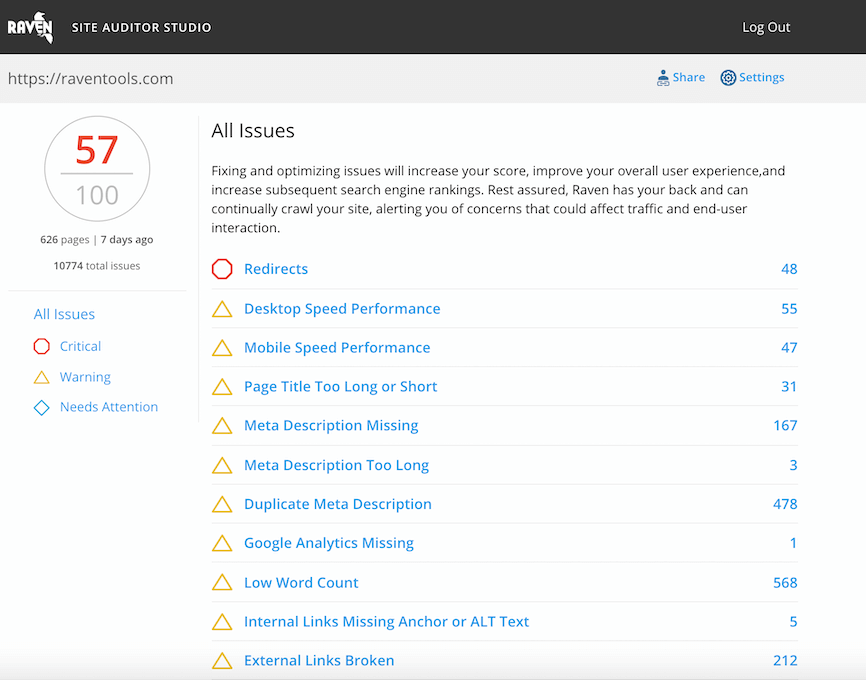
Analyze over 20 different technical SEO issues and create to-do lists for your team while sending error reports to your client.




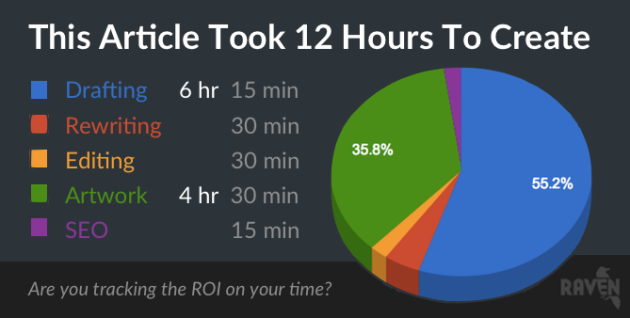
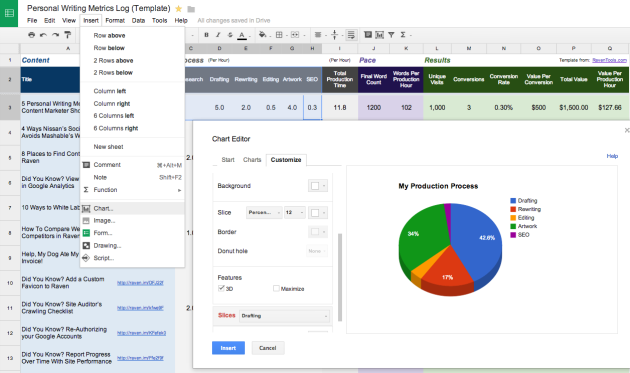

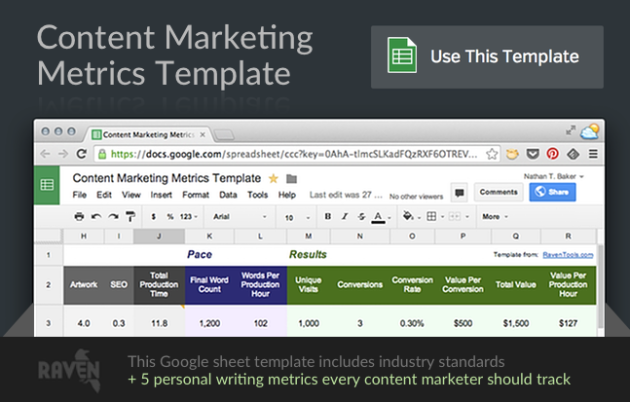
This is good advice. Thanks.
I’m glad you found it useful! 🙂
Love this. Going to give it a shot.
Yep, I’m up for the challenge, too 🙂
Thank you for sharing.
Great, let me know how it goes!